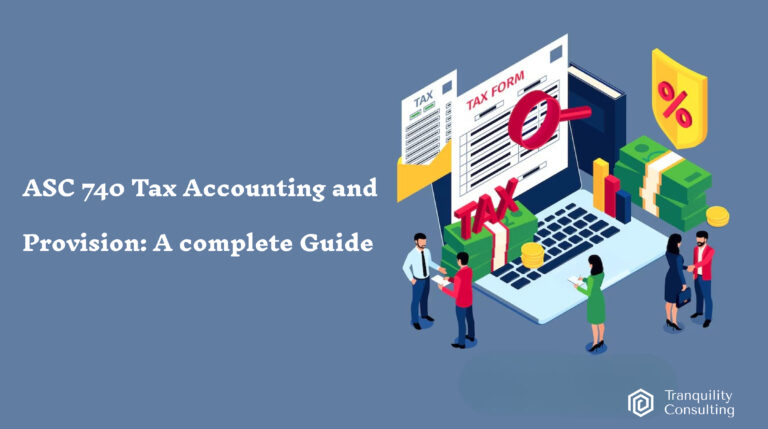What is ASC 740 Tax Accounting?
ASC 740 Tax Accounting refers to the Accounting Standards Codification (ASC) section that outlines how companies should account for income taxes under Generally Accepted Accounting Principles (GAAP) in the United States. It provides guidelines on recognizing, measuring, and disclosing deferred tax assets and liabilities in financial statements. The objective of ASC 740 is to align the company’s financial statement income with its taxable income and ensure that income tax obligations are correctly recorded. Deferred taxes arise when there are temporary differences between the income reported on financial statements and those reported to tax authorities. ASC 740 addresses how companies should treat these differences to provide a clear and consistent picture of the company’s financial health and tax obligations.
Why is ASC 740 needed?
ASC 740 must create transparency and consistency in how businesses report their tax liabilities. Tax rules often differ from accounting rules, creating discrepancies between a company’s financial and tax reporting. ASC 740 Tax Accounting addresses these gaps by ensuring that taxes are accounted for correctly.
Here’s why ASC 740 is essential:
- Transparency: Ensures companies provide accurate information about their tax liabilities and deferred taxes.
- Comparability: Helps investors and other stakeholders compare the tax positions of different companies.
- Compliance allows companies to adhere to GAAP and maintain trust with investors, regulatory bodies, and financial markets.
Without proper ASC 740 tax accounting, companies might inaccurately report their tax obligations, potentially leading to restatements, fines, or legal complications.
Scope of ASC 740 Tax Accounting
The scope of ASC 740 Tax Accounting covers all entities that report under GAAP and have tax-related activities that result in differences between their financial and tax reporting. It applies to:
- Public companies listed in the U.S.
- Private entities that follow GAAP for financial reporting.
- Non-profit organizations with taxable activities.
- Multinational corporations with complex tax situations.
ASC 740 addresses several key areas:
- Deferred Tax Assets and Liabilities: Temporary differences between taxable income and financial statement income.
- Uncertain Tax Positions: A company has taken or expects to take on a tax return that tax authorities might challenge.
- Valuation Allowance: Determining whether deferred tax assets can be realized.
- Tax Rate Changes: Adjusting deferred taxes for changes in tax rates.
By encompassing these areas, ASC 740 ensures that businesses recognize tax-related obligations consistently, providing clarity in financial statements.
How to Calculate ASC 740 Tax Accounting
Calculating ASC 740 involves identifying temporary differences, recognizing deferred tax assets and liabilities, and adjusting for future changes in tax laws or tax rates. Here’s a step-by-step process for calculating ASC 740 Tax Accounting
Step 1: Identify Temporary Differences
Temporary differences arise when the income reported for financial statement purposes differs from the taxable income reported to tax authorities. Familiar sources of temporary differences include:
- Depreciation: Different methods used for tax and financial reporting.
- Revenue recognition: Differences between recognizing revenue for tax and accounting purposes.
- Accruals: Expenses accrued for financial statements are deductible in different periods for tax purposes.
Step 2: Calculate Deferred Tax Assets and Liabilities
Once temporary differences are identified, calculate the deferred tax assets (future tax benefits) and deferred tax liabilities (future tax obligations). Deferred taxes are measured by multiplying the temporary differences by the enacted tax rate expected to be in effect when the temporary differences reverse.
The basic formula for calculating ASC 740 Tax Accounting involves determining the deferred tax amounts and applying the appropriate tax rate to the temporary differences.
Here’s the formula:
Deferred Tax Asset / Liability = Temporary Difference × Enacted Tax Rate
Where:
- Temporary Difference: The difference between book income and taxable income.
- Enacted Tax Rate: The tax rate is expected to apply when the temporary difference reverses.
For uncertain tax positions, the calculation is based on the “more likely than not” standard, requiring companies to estimate the amount of tax benefit likely to be sustained under examination by tax authorities.
Step 3: Recognize Uncertain Tax Positions
For uncertain tax positions, determine whether it is “more likely than not” that the tax position will be sustained upon examination by tax authorities. If it is, measure the benefit at the most significant amount greater than 50% likely to be realized.
Step 4: Apply Valuation Allowances
If it is unlikely that deferred tax assets will be realized, apply a valuation allowance to reduce the deferred tax asset to the amount that is more likely than not to be realized.
Step 5: Adjust for Tax Rate Changes
If future tax rates are expected to change, adjust deferred tax assets and liabilities accordingly. The ASC 740 tax accounting calculation needs to reflect the tax rates enacted for future periods.
Reports & Disclosure Requirements for ASC 740 Compliance
ASC 740 Tax Accounting requires extensive reporting and disclosure to provide stakeholders with a clear understanding of a company’s tax position. Here’s what companies need to disclose:
- Deferred Tax Assets and Liabilities: Companies must report the amounts of deferred tax assets and liabilities on the balance sheet.
- Valuation Allowances: Disclose any valuation allowances applied to reduce deferred tax assets.
- Uncertain Tax Positions: Provide details on uncertain tax positions, including a description of the positions and the amounts recognized or unrecognized.
- Practical Tax Rate Reconciliation: Reconcile the statutory tax rate to the company’s effective tax rate, detailing major reconciling items like foreign taxes, state taxes, and non-deductible expenses.
- Tax Rate Changes: Disclose the impact of enacted changes in tax rates on deferred tax assets and liabilities.
This level of transparency allows investors, auditors, and regulators to assess the company’s tax strategies and potential risks more effectively.
What Income Taxes are Covered by ASC 740?
ASC 740 primarily applies to federal, state, and local income taxes within the U.S., but it also extends to foreign taxes for companies with international operations. Here’s a breakdown of the taxes covered by ASC 740:
- U.S. federal income tax: The primary focus of ASC 740.
- State and local income taxes: Many states and localities impose their income tax systems.
- Foreign income taxes: For multinational companies, ASC 740 addresses taxes paid to foreign jurisdictions.
- Deferred tax liabilities: Address income that will be taxed in future periods.
ASC 740 does not apply to non-income taxes, such as sales, property, or payroll.
FAQs
1. What is ASC 740 in tax accounting?
- ASC 740 refers to the section of GAAP that governs the accounting for income taxes, addressing deferred tax assets and liabilities.
2. Why is ASC 740 crucial for businesses?
- ASC 740 ensures accurate reporting of income taxes, aligning financial and tax reporting for transparency and regulatory compliance.
3. How do you calculate deferred tax under ASC 740?
- Deferred taxes are calculated by multiplying the temporary difference between financial and taxable income by the enacted future tax rate.
4. What types of taxes are covered by ASC 740?
- ASC 740 covers U.S. federal, state, and local income taxes and foreign taxes, but it does not apply to non-income taxes like sales or payroll taxes.
5. What are uncertain tax positions under ASC 740?
- Uncertain tax positions are tax treatments that tax authorities may not fully uphold, requiring an evaluation of the likelihood of being sustained.
If you have any questions or need business-related tax consulting advice, please get in touch with us at: [email protected]





